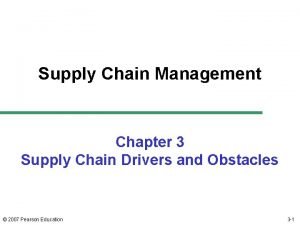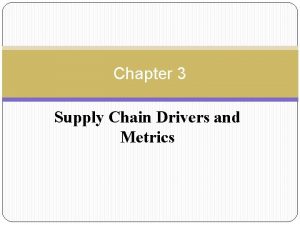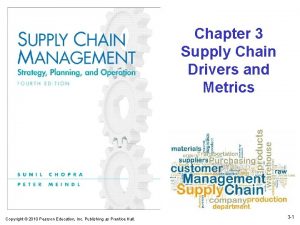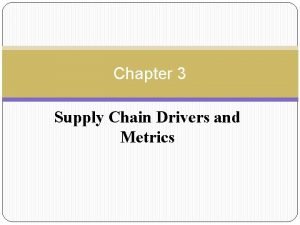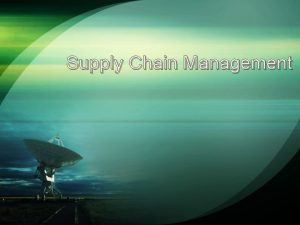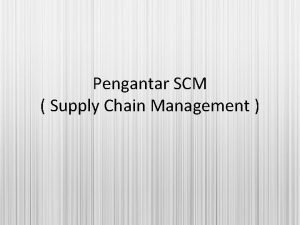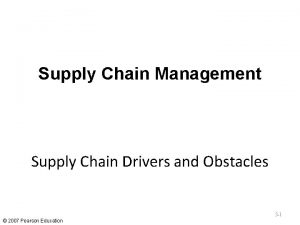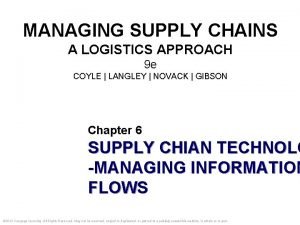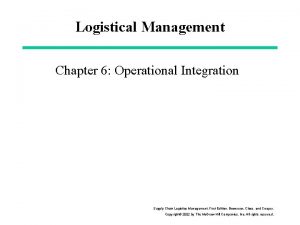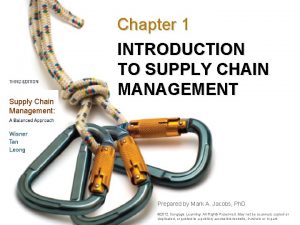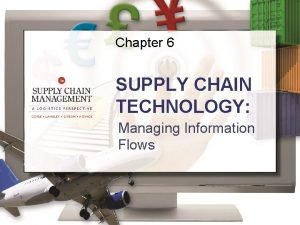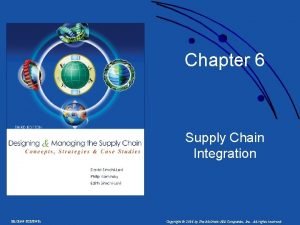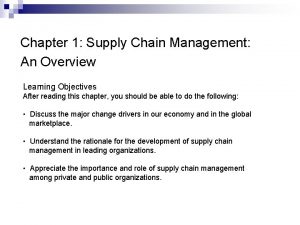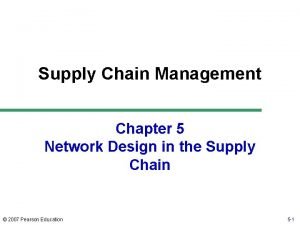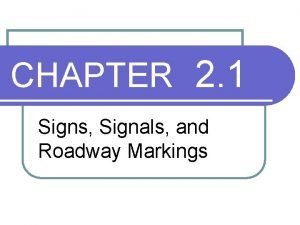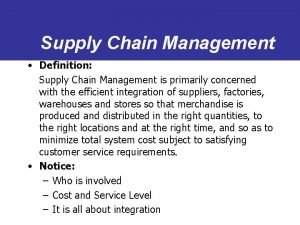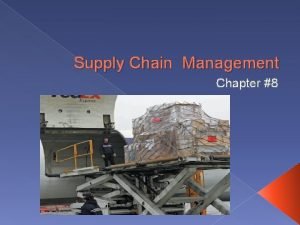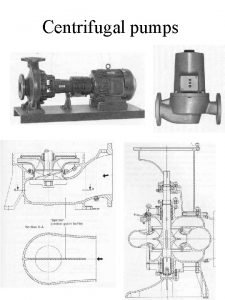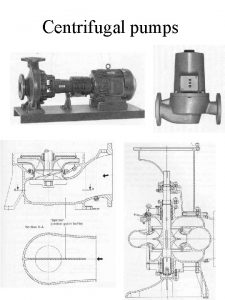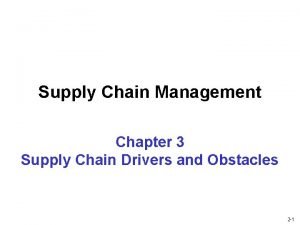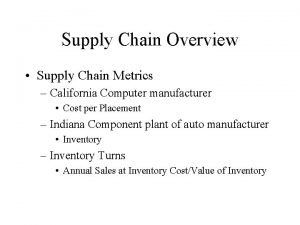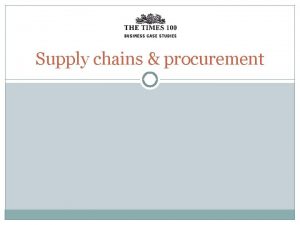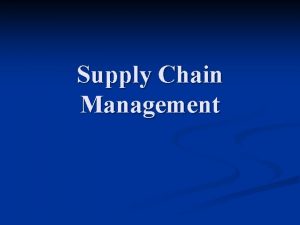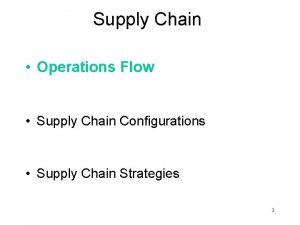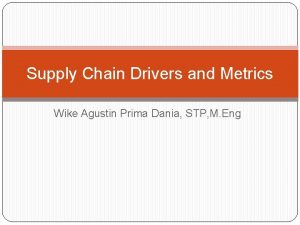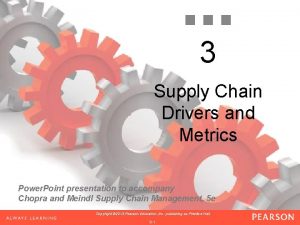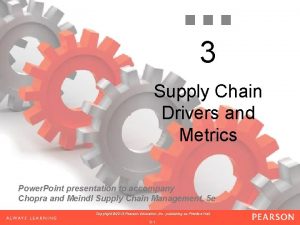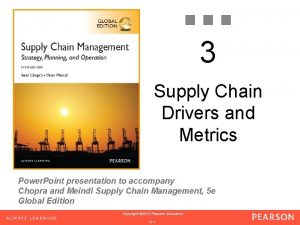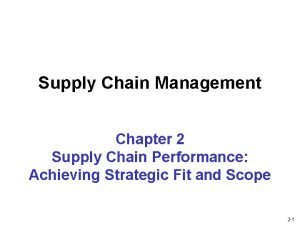Chapter 3 Supply Chain Drivers and Metrics IMPELLERS
























- Slides: 24

Chapter 3 Supply Chain Drivers and Metrics

IMPELLERS OF SUPPLY CHAIN Empowered Customer Developments in Information Technology Tools Globalisation 3 -2

SUPPLY CHAIN CONCEPTS Systems Concept Multiple organizations Intracompany, interfunctional and interdependence Total Cost Concept Integrated system Trade off Concept Responsiveness Vs. Efficiency 3 -3

Drivers of Supply Chain Performance Facilities places where inventory is stored, assembled, or fabricated production sites and storage sites Inventory raw materials, WIP, finished goods within a supply chain inventory policies Transportation moving inventory from point to point in a supply chain 3 -4 combinations of transportation modes and routes

Information data and analysis regarding inventory, transportation, facilities throughout the supply chain potentially the biggest driver of supply chain performance Sourcing functions a firm performs and functions that are outsourced Pricing Price associated with goods and services provided by a firm to the supply chain

A Framework for Structuring Drivers Figure 3 -1

Facilities places where inventory is stored, assembled, or fabricated production sites and storage sites ROLE IN THE SUPPLY CHAIN If we think of inventory as what is being passed along the supply chain and transportation as how it is passed along, then facilities are the where of the supply chain. They are the locations to or from which the inventory is transported.

Role In The Competitive Strategy Facilities are a key driver of supply chain performance in terms of responsiveness and efficiency. Example 3 -1: Toyota and Honda Both Toyota and Honda use facilities decisions to be more responsive to their customers. These companies have an end goal of opening manufacturing facilities in every major market that they enter. While there are other benefits to opening local facilities, such as protection from currency fluctuation and trade barriers, the increase in responsiveness plays a large role in Toyota and Honda's decision to place facilities in their local markets.

COMPONENTS OF FACILITIES DECISIONS Decisions regarding facilities are a crucial part of supply chain design. We now identify components of facilities decisions that companies must analyze. Role For production facilities, firms must decide whether they will be flexible, dedicated, or a combination of the two. Flexible capacity can be used for many types of products but Location Deciding where a company will locate its facilities constitutes a large part of the design of a supply chain. A basic trade-off here is whether to centralize in order to gain economies of scale or to decentralize to become more responsive by being closer to the customer.

Capacity Companies must also determine a facility's capacity to perform its intended function or functions. A large amount of excess capacity allows the facility to be very flexible and to respond to wide swings in the demands placed on it. Excess capacity, however, costs money and therefore can decrease efficiency. Facility-Related Metrics Capacity Utilization Theoretical flow/cycle time of production Actual average flow/cycle time Flow time efficiency Product variety Volume contribution of top 20 percent SKUs and customers Processing/setup/down/idle time Average production batch size Production service level

OVERALL TRADE-OFF: RESPONSIVENESS VERSUS EFFICIENCY The fundamental trade-off that managers face when making facilities decisions is between the cost of the number, location, and type of facilities (efficiency) and the level of responsiveness that these facilities provide the company's customers.

INVENTORY raw materials, WIP, finished goods within a supply chain ROLE IN THE SUPPLY CHAIN Inventory exists in the supply chain because of a mismatch between supply and demand. An important role that inventory plays in the supply chain is to increase the amount of demand that can be satisfied by having the product ready and available when the customer wants it. Another significant role that inventory plays is to reduce cost by exploiting economies of scale that may exist during production and distribution.

ROLE IN THE COMPETITIVE STRATEGY Inventory plays a significant role in a supply chain's ability to support a firm's competitive strategy. If a firm's competitive strategy requires a very high level of responsiveness, a company can achieve this responsiveness by locating large amounts of inventory close to the customer. Conversely, a company can also use inventory to become more efficient by reducing inventory through centralized stocking. The latter strategy would support a competitive strategy of being a low cost producer. Example 3 -2: Nordstrom's competitive strategy targets upper-end customers with high responsiveness requirements. These customers are willing to pay a premium to have the products they want when they want them. To support this competitive strategy, Nordstrom uses inventory; the company stocks a large variety and quantity of products to ensure a high level of availability. In fact, Nordstrom stocks a significantly larger amount of inventory than other department stores.

COMPONENTS OF INVENTORY DECISIONS Cycle Inventory Cycle inventory is the average amount of inventory used to satisfy demand between receipts of supplier shipments. Safety Inventory Safety inventory is inventory held in case demand exceeds expectation; it is held to counter uncertainty. Seasonal Inventory Seasonal inventory is built up to counter predictable variability in demand. Level of Product Availability Level of product availability is the fraction of demand that is served on time from product held in inventory.

Inventory-Related Metrics A manager should track the following inventory-related metrics that influence supply chain performance. Average inventory Products with more than a specified number of days of inventory Average replenishment batch size Average safety inventory Seasonal inventory Fill rate Fraction of time out of stock Overall Trade-Off: Responsiveness Versus Efficiency The fundamental trade-off that managers face when making inventory decisions is between responsiveness and efficiency. Increasing inventory generally makes the supply chain more responsive to the customer.

TRANSPORTATION Transportation moving inventory from point to point in a supply chain combinations of transportation modes and routes ROLE IN THE SUPPLY CHAIN Transportation moves product between different stages in a supply chain. Like the other supply chain drivers, transportation has a large impact on both responsiveness and efficiency. Faster transportation allows a supply chain to be more responsive but reduces its efficiency. The type of transportation a company uses also affects the inventory and facility locations in the supply chain. Dell, for example, flies some components from Asia because doing so allows the company to lower the level of inventory it holds. Clearly, such a practice also increases responsiveness but decreases transportation efficiency because it is more costly than transporting parts by ship.

ROLE IN THE COMPETITIVE STRATEGY The role of transportation in a company's competitive strategy figures prominently in the company's consideration of the target customer's needs. If a firm's competitive strategy targets a customer who demands a very high level of responsiveness, and that customer is willing to pay for this responsiveness, then a firm can use transportation as one driver for making the supply chain more responsive. The opposite holds true as well. If a company's competitive strategy targets customers whose main decision criterion is price, then the company can use transportation to lower the cost of the product at the expense of responsiveness. Because a company may use both inventory and transportation to increase responsiveness or efficiency, the optimal decision for the company often means finding the right balance between the two.

Example 3 -3: Laura Ashley sells clothing and other household items through a mail-order catalog and uses transportation as part of its competitive strategy. Laura Ashley's customers are willing to pay a premium price for a high level of responsiveness. To meet this level of responsiveness, the company has located its main warehouse near the Fed. Ex hub in Memphis, Tennessee, to better utilize the responsive transportation that Fed. Ex offers. When an order is placed, the goods are easily and quickly sent from the Laura Ashley warehouse to the Fed. Ex hub, where they are sent overnight to the customer. This transportation policy enables Laura Ashley's customers to order their goods later than they can at other companies and still receive them next day.

COMPONENTS OF TRANSPORTATION DECISIONS Design of Transportation Network The transportation network is the collection of transportation modes, locations, and routes along which product can be shipped. A company must decide whether transportation from a supply source will be direct to the demand point or will go through intermediate consolidation points. Choice of Transportation Mode The mode of transportation is the manner in which a product is moved from one location in the supply chain network to another. Companies can choose between air, truck, rail, sea, and pipeline as modes of transport for products.

Transportation-Related Metrics A manager should track the following transportation-related metrics that influence supply chain performance. Average inbound transportation cost Average incoming shipment size Average inbound transportation cost per shipment Average outbound transportation cost Average outbound shipment size Average outbound transportation cost per shipment Fraction transported by mode Overall Trade-Off: Responsiveness Versus Efficiency The fundamental trade-off for transportation is between the cost of transporting a given product (efficiency) and the speed with which that product is transported (responsiveness). Using fast modes of transport raises responsiveness and transportation cost but lowers the inventory holding cost.

Information data and analysis regarding inventory, transportation, facilities throughout the supply chain potentially the biggest driver of supply chain performance ROLE IN THE SUPPLY CHAIN Information deeply affects every part of the supply chain. Its impact is easy to underestimate, as information affects a supply chain in many different ways. Consider the following: Information serves as the connection between various stages of a supply chain, allowing them to coordinate and maximize total supply chain profitability. Information is also crucial to the daily operations of each stage in a supply chain. For instance, a production scheduling system uses information on demand to create a schedule that allows a factory to produce the right products in an efficient manner. A warehouse management system uses information to create visibility of the warehouse's inventory. The company can then use this information to determine whether new orders can be filled.

ROLE IN THE COMPETITIVE STRATEGY Information is an important driver that companies have used to become both more efficient and more responsive. The tremendous growth of the importance of information technology is a testimony to the impact that information can have on improving a company. Like all the other drivers, however, even with information, companies reach a point when they must make the trade-off between efficiency and responsiveness. Example 3 -5: Dell takes orders directly from consumers over the phone and via the Internet. Building this direct channel required an investment because of the added functions Dell must perform. A large part of that cost can be attributed to information. With the direct channel model, however, Dell is able to view the actual consumer demand much sooner than most PC manufacturers. Therefore, the company can respond more quickly to changes in consumer needs. Dell can then modify its product offerings to meet these new needs.

SOURCING functions a firm performs and functions that are outsourced ROLE IN THE SUPPLY CHAIN Sourcing is the set of business processes required to purchase goods and services. Managers must first decide which tasks will be outsourced and those that will be performed within the firm. For each outsourced task, the manager must decide whether to source from a single supplier or a portfolio of suppliers. ROLE IN THE COMPETITIVE STRATEGY Sourcing decisions are crucial because they affect the level of efficiency and responsiveness the supply chain can achieve. In some instance, firms outsource to responsive third parties if it is too expensive for them to develop this responsiveness on their own. Firms also outsource for efficiency if the third party can achieve significant economies of scale or has a lower underlying cost structure for other reasons. Outsourcing decisions should be driven by the desire for growth in total supply chain profitability. Example 3 -6: Cisco has outsourced almost all of its manufacturing. It does, however, have a sourcing strategy that varies by product type. For low-end products such as routers for home networks, Cisco aims for efficiency. These routers are produced and packed in China and shipped in bulk for sale in the United States. Cisco aims for the lowest-cost manufacturing location and economies of scale in transportation because the targeted market segment values low cost. For high-end products, in contrast, Cisco outsources to contract manufacturers in the United States. These manufacturers are not cheap but they are responsive and can serve the rapidly evolving needs of the high-end market.

Pricing Price associated with goods and services provided by a firm to the supply chain ROLE IN THE SUPPLY CHAIN Pricing is the process by which a firm decides how much to charge customers for its goods and services. Pricing affects the customer segments that choose to buy the product, as well as the customer's expectations. This directly affects the supply chain in terms of the level of responsiveness required as well as the demand profile that the supply chain attempts to serve. Pricing is also a lever that can be used to match supply and demand. Short-term discounts can be used to eliminate supply surpluses or decrease seasonal demand spikes by moving some of the demand forward. ROLE IN THE COMPETITIVE STRATEGY Pricing is a significant attribute through which a firm executes its competitive strategy. For example, Costco, a membership-based wholesaler in the United States, has a policy that prices are kept steady but low. Customers expect low prices but are comfortable with a lower level of product availability. The steady prices also ensure that demand stays relatively stable. Costco serves a well-defined segment, and it can thus design an appropriate supply chain. The Costco supply chain aims to be very efficient, at the expense of some responsiveness. In contrast, some manufacturing and transportation firms use pricing that varies with the response time desired by the customer.
 Drivers in supply chain
Drivers in supply chain Framework for structuring drivers
Framework for structuring drivers Supply chain drivers and metrics
Supply chain drivers and metrics Supply chain drivers and metrics
Supply chain drivers and metrics Impellers of supply chain
Impellers of supply chain Supply chain drivers and obstacles
Supply chain drivers and obstacles Supply chain drivers and obstacles
Supply chain drivers and obstacles Drivers of supply chain management
Drivers of supply chain management Lean warehousing definition
Lean warehousing definition Six drivers of supply chain excellence
Six drivers of supply chain excellence Matching supply and demand in supply chain
Matching supply and demand in supply chain Value chain and supply chain difference
Value chain and supply chain difference Grazing food chain diagram
Grazing food chain diagram Chapter 5 section 1 supply and the law of supply
Chapter 5 section 1 supply and the law of supply Chapter 6 supply chain management
Chapter 6 supply chain management Chapter 1 supply chain management
Chapter 1 supply chain management Chapter 6 supply chain management
Chapter 6 supply chain management Dell supply chain case study
Dell supply chain case study Chapter 1 supply chain management
Chapter 1 supply chain management Network design in the supply chain chapter 5
Network design in the supply chain chapter 5 Chapter 2 signs signals and roadway markings
Chapter 2 signs signals and roadway markings Chapter 2 signs signals and roadway markings answer key
Chapter 2 signs signals and roadway markings answer key A short section of corrugated roadway
A short section of corrugated roadway Supply chain management explanation
Supply chain management explanation Supply chain upstream and downstream
Supply chain upstream and downstream
